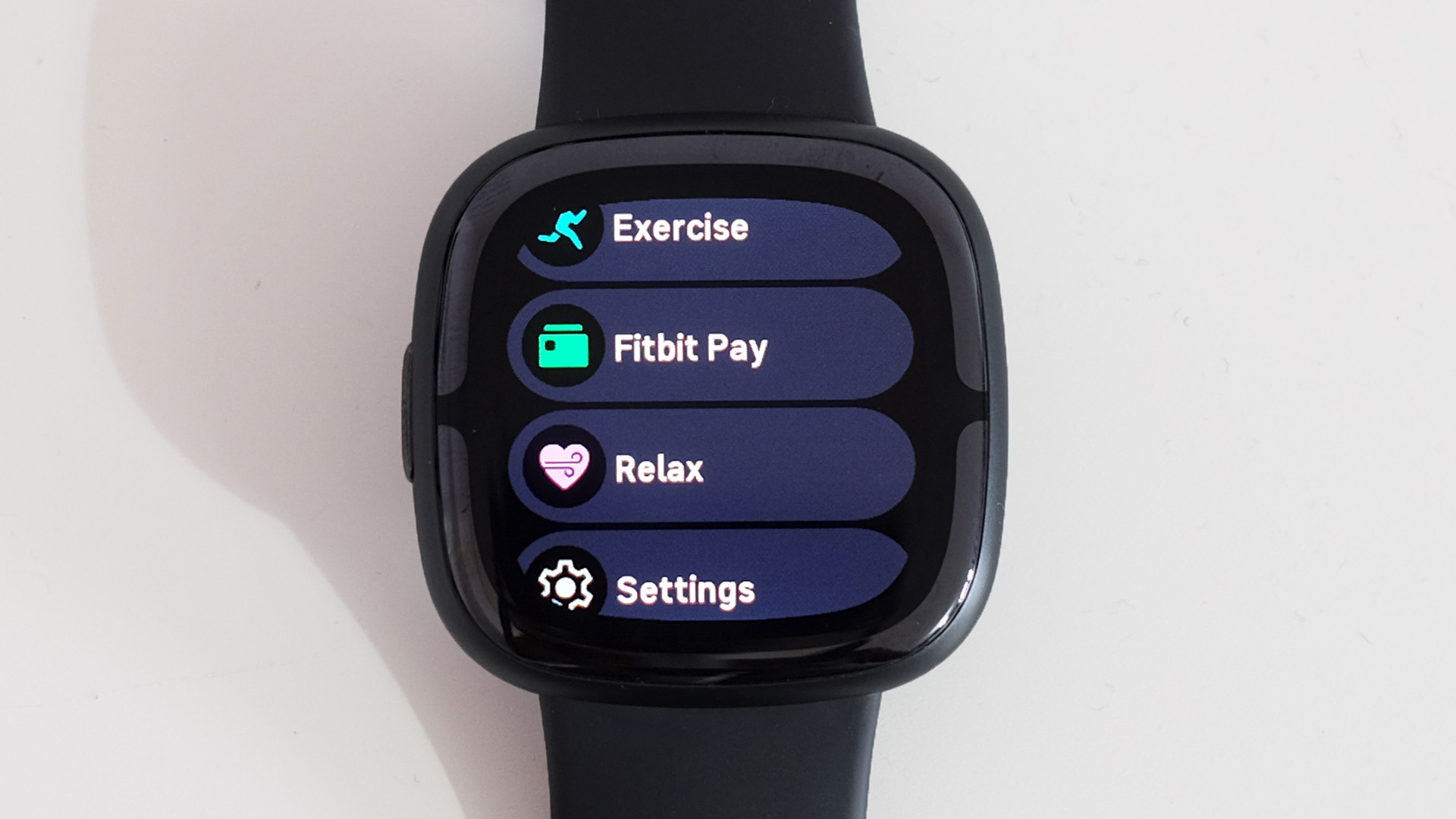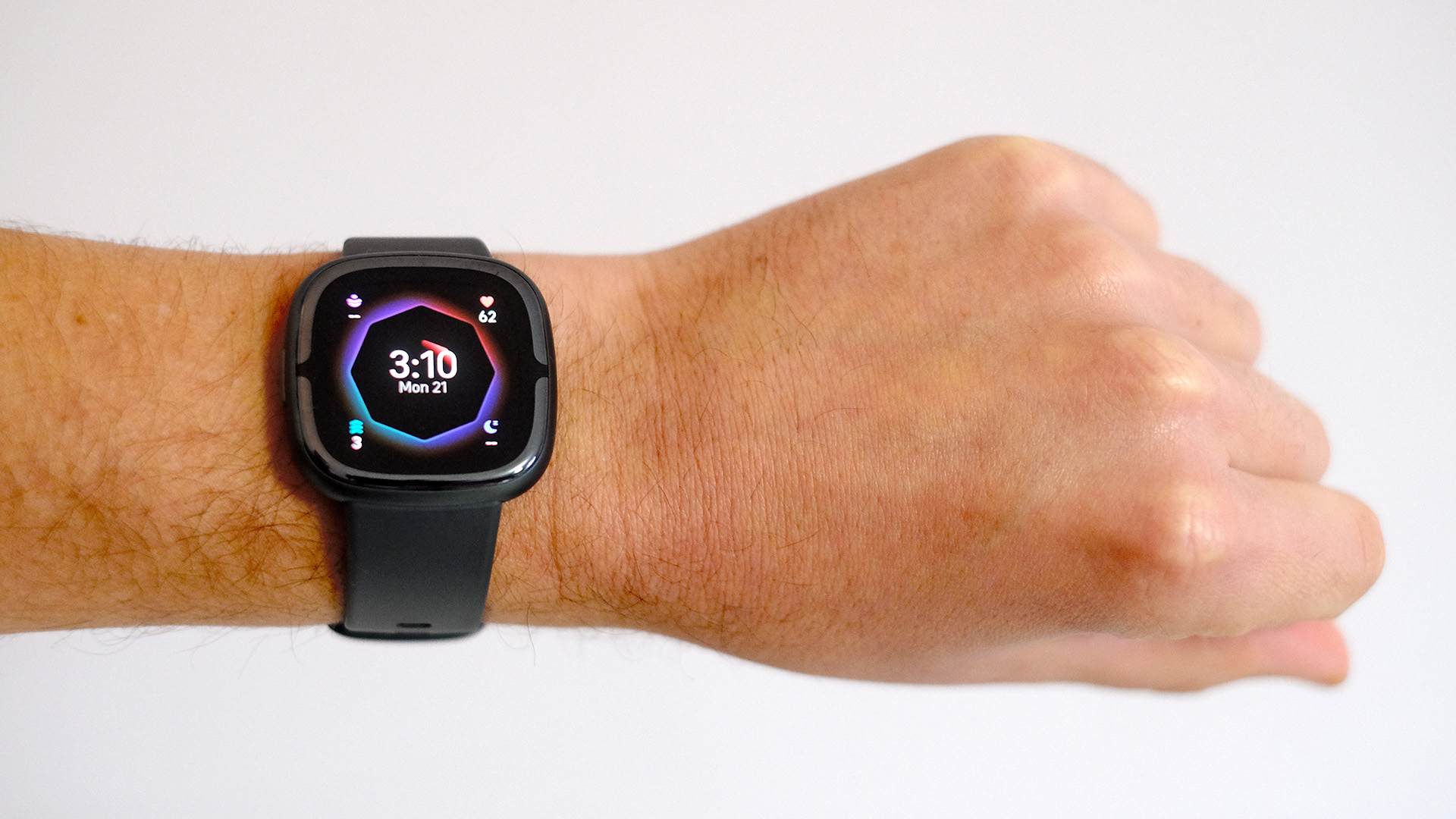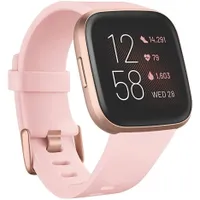TechRadar Verdict
The Fitbit Sense 2 is an enjoyable-to-use casual health and fitness tracker that demands less upkeep than an Apple Watch, but the new closed-off approach for this series makes the watch less flexible than its predecessor.
Pros
- +
Good battery life
- +
Comfortable
- +
Fairly easy-to-understand interface
Cons
- -
No music support
- -
Heart rate reliability is not top-tier
- -
Subscription is required to unlock its full powers
- -
No third-party app support
Why you can trust TechRadar
The Fitbit Sense 2 is the flagship Fitbit watch for 2022. It takes the health-tracking obsession of the original Fitbit Sense, improves stress-tracking flexibility, and adds a physical button instead of a finicky pressure-sensitive spot on the side.
It’s an improvement, but the Sense 2 also feels like a downgrade from the best Fitbit in some important ways. Third-party app support has been removed, meaning you could argue this is no longer a real smartwatch. And in this move, the Fitbit Sense 2 loses any form of music support — no playback, no control of what’s played on your phone.
It leaves the Fitbit Sense 2 without as clear a sense of direction as we’d like. However, it’s still a good fit for passive, casual health and fitness tracking, and for those who have a lighter workout routine, where somewhat patchy heart rate accuracy won’t be a deal-breaker.
However, as the most recent flagship Fitbit, you will be able to grab one at discount in the Black Friday Fitbit deals, increasing the value of the total package.
Fitbit Sense 2: Price and availability
The Fitbit Sense 2 is the top-end Fitbit watch. Now Google owns Fitbit, it effectively slots in above the Versa 4, below the Google Pixel Watch.
You’ll pay up to $299.95/£269.99/$447AU for the watch, its launch price. Fitbit released the Sense 2 in September 2022, two years after the original Sense.
Fitbit Sense 2: Design
- Similar look and feel as last year
- Tactile button makes welcome return
- Swimproof
If you are already familiar with the Fitbit Sense series and are hoping for something new-looking in the Sense 2, we have bad news. The two generations of watches have similar looks, and the big design change is as much a mea culpa as anything else.
Sign up for breaking news, reviews, opinion, top tech deals, and more.
Fitbit has added a physical button to the Sense 2. All those complaints about the annoying touch panel on the original paid off. The Sense 2 design isn’t super-fresh, then, but the look has only noticeably aged in one dimension. Apple’s Watch Series 8 has a super-slim bezel, while the Fitbit Sense 2 a big ole’ chunky one, just like the original.
However, this isn’t obvious all the time, just in certain lighting conditions that highlight where the screen ends, because the Sense 2 display is an OLED panel. It’s the ideal tech for a smartwatch because emissive pixels let unlit parts of the screen sink into the background.
Materials are the same as the original too. The Fitbit Sense 2 has a lightly domed glass face, one much more square-shaped than most. Its sides are aluminum and much of the back is plastic.
We’ve used a whole bunch of smartwatches recently, including the Pixel Watch, Apple Watch Series 8 and Garmin Epix 2. The Fitbit Sense 2 has the least sharp display of the bunch, but you’ll only notice if you look unusually close, to see the slight fuzziness to text. It’s otherwise bright and colourful, and has an always-on mode worth trying if you’re happy with two-to-three days of battery life rather than six.
The Fitbit Sense 2 is absolutely a watch you can wear more-or-less 24 too. It’s light, and 5ATM water resistance means it’s happy enough in the shower or swimming pool.
- Design score: 4/5

Fitbit Sense 2: Features
- Redesigned Fitbit OS
- No third-party app support
- Little smartwatch capacity
So far, so original Fitbit Sense. However, the Fitbit OS interface has been given a revamp in the Sense 2, and it brings the layout much closer to that of the Pixel Watch. This makes sense when you consider Google now owns Fitbit, and these watches have to find a way to live in harmony — or at least as much as family members tend to. The change is actually a positive one as well.
You flick left and right from the watch face to see your daily stat screens. There’s a sum up of the day’s stats, a graph of your heart rate over the day, a weather report, and a few other bits — Fitbit staples. You flick up from the watch face to see notifications, which look great on the Sense’s good-size screen. And a press of the side button takes you to the Sense 2’s take on an apps menu. This holds some of the stuff you can access in those stat screens, plus some smarter extras.
However, one of the key takeaways of our weeks using the Sense 2 is how much less of a smartwatch the Fitbit Sense 2 seems today than top-end Fitbits did a few years ago. The company has discontinued support for third-party apps. Fitbit hasn’t had a good app scene for quite a while now, but at least the original Fitbit Sense had a Spotify app. That’s gone.
The Fitbit Sense 2 is, for now at least, limited to what you get fresh out of the box. In smart feature terms the mean wireless payments through Fitbit Pay and smart assistant support via Amazon Alexa. This may sound bizarre when Google has Assistant, and Google has a better-supported wireless payments service called Google Wallet (+Pay). Google is reportedly flinging this to Sense 2s as we write this, but it has not reached our Sense just yet, and Alexa support is limited too.
The Fitbit Sense 2 has a speaker, so you do get that full voice assistant experience of asking for something, and hearing a disembodied voice replying complete with some on-watch visual feedback. But Alexa only works when connected to your phone because the Sense 2 has no Wi-Fi. Or, to be more precise, it has no active Wi-Fi as the watch apparently does have the capability but Wi-Fi is disabled in the software.
More important than any of this, the Sense 2 also lacks any kind of music support. You can’t store music on the watch, Spotify support has been discontinued and you can’t even control the music played on a connected phone.
No third-party apps, no Wi-Fi, no music — the Sense 2 isn’t much of a smartwatch. It skims the surface of this category, offering notifications and wireless payments but little more. What separated the Sense line from the cheaper Charge 5 has largely been lost.
Fitbit handles this shift badly too because you can still browse through the apps you can’t download on the Fitbit app on your phone. Some new stuff is coming, though. Google Maps support is on the way, offering turn-by-turn navigation while connected to your phone.
- Features score: 2.5/5
Fitbit Sense 2: Performance
- Small issues with EDA
- Large issues with heart rate accuracy
- Good GPS connection
- Some features locked behind Premium
The Fitbit Sense 2 is not a great smartwatch, but it does have the series’s staple health bent. This means it has an ECG sensor and the company’s electrodermal activity sensor, or EDA. ECG looks at your heart rhythm for signs of atrial fibrillation. You have to put your thumb and forefinger to the bezel and wait for 30 seconds, but it’s a neat piece of tech. Our only issue is that it won’t work if your resting heart rate is below 50. Ours occasionally heads down to 47-48bpm, but that’s not exactly normal so Fitbit gets a pass here.
Fitbit also fills in for the fact active participation is required by offering high and low heart rate notifications. If the watch spots something odd, you’ll get an alert and may take this as a prompt to fire up the Sense 2 ECG. The original Sense had a similar issue with its stress-tracking EDA sensor. It tracks stress by analysing your sweat production, but in the old model you had to sit there with your hand over the screen, so your palm was laid over the sensors.
Now you only have to do that if you want to, because the Fitbit Sense 2 can also use a rear sensor to watch out for “body response” events that may indicate stress. It’s not going to work as well, of course. Sweaty palms are a thing, but sweaty-upper-wrist-bit? Less so. When one of these responses is noticed, your watch will ask how you’re feeling and log it in the Fitbit app. It’s not that exciting unless you’re really into this particular brand of wellness tracking.
Stress and heart health sensors aside, the Sense 2 is otherwise matched by the Fitbit Versa 4. It has full GPS, an optical heart rate reader that can also record blood oxygenation stats, and there’s an altimeter to count the flights of stairs you climb each day. This is the full package, but we don’t find certain elements of the Fitbit Sense 2’s stat accuracy all that good. The GPS side is perfectly solid, apart from taking quite a while to lock on when tracking in a completely new location or after several days of non-use.
While the Sense 2 does not have Multi-Band GPS like some of the high-end Garmins or an Apple Watch Ultra, it was able to hold onto signal throughout all our outdoors tracked workouts. Heart rate accuracy is a different story, though, as the Sense 2’s readings were a mess for the first few minutes of tracking each time. We’ve been trying out some longer, lower heart rate sessions of late, and the Sense 2 typically records a far too high rate for the first 4-5 minutes before finally settling into the groove and doing an all-around better job.
Curiously, this issue was far more severe than what we saw in the Fitbit Versa 4, which tended to overshoot the rate of exertion spikes before re-aligning its readings with reality fairly swiftly. The Fitbit Sense 2 may well have had a software update that improves matters by the time you read this, but we’d still very much trust an Apple Watch SE or Garmin Forerunner 255 over this watch. And while its “40-plus” exercise modes may sound impressive, we found too many of them to be generic or vanilla, with only the programmable HIIT interval mode offering something a bit beyond the basics.
The Fitbit Sense 2 is stronger when viewed as an all-round holistic health watch than a dedicated fitness one. To get the most from it, though, you need to sign up to Fitbit’s Premium service. This is a $9.99/£9.99 a month exercise and wellness subscription that unlocks video workouts, guided meditations and nutrition plans. You can consider it an alternative to Apple’s Fitness+, although it doesn’t show watch stats on-screen, one of the neatest Fitness+ characteristics.
A bunch of stats are also only unlocked to Premium members. These include the entire “insights” section, which shows long-term trends in recorded stats, Training Readiness, sleep restlessness and snoring. The Fitbit Sense 2 does enough to seem, and be, useful without these extras. A subscription is not all-but mandatory. But having the reminder in the app that the watch’s full strength is only unlocked with a paid subscription may be frustrating for some.
- Performance score: 3/5

Fitbit Sense 2: Battery life
- Around five days of battery life with moderate GPS use
- Always-on display reduces this to 2-3 days
- An hour's run takes 10% off battery
A Fitbit Sense 2 has some issues, but it still has one great big advantage over the rival Apple Watch SE: battery life. Despite looking and running like a smartwatch (at least until you go looking for more advanced smartwatch features), it lasts much longer than one.
Fitbit says the Sense 2 will last six days between charges. We saw it last around five days, but real-world stamina is going to vary depending on, for example, how much you use the GPS. Tracking a run for an hour typically takes 10% off the charge level, a rate far higher than when it counts steps passively, as you’d expect.
When you get to the point of charging your watch once a week rather than once a day, wearable battery annoyances all but disappear. However, if you use the Sense 2’s always-on display mode you can expect the battery to roughly halve, leaving you with somewhere around 2.5-3 days between charges.
- Battery life score: 4/5
Buy it if...
You want a health and well-being watch
The Fitbit Sense 2 is unusual in that it has a broad focus on a bunch of everyday health aspects rather than focusing 100% on exercise and fitness. Its unusual specialisms are stress and sleep.
You demand fairly good battery life
The Fitbit Sense 2 lasts up to around a week between charges, far longer than an Apple Watch or the Google Pixel Watch. Sure, some Garmins last longer, but not the ones with OLED screens that don’t cost an absolute fortune.
You want a watch for sleep tracking
Long battery life and decent general comfort makes the Fitbit Sense 2 a solid pick for those after sleep tracking. Fitbit also offers more advanced stats than most when you subscribe to its Premium service.
Don't buy it if...
You want a true smartwatch
The Fitbit Sense 2 is not as much of a smartwatch as you may hope for. It doesn’t support music playback or control, and third-party app support is gone too. While it has smart features, the flexibility of a real smartwatch isn’t really here.
You’re picky about fitness stat accuracy
We don’t rate the Fitbit Sense 2’s heart rate accuracy that highly. This mostly seems to affect the first few minutes of a workout, and things improve afterwards. But if you like to keep your sessions short and regular, it could have a real affect on your summary results.
You demand real innovation
The original Sense was a health and stress tracking trailblazer, but the Sense 2 makes fairly minor changes. The most notable substantive change is the ability to sense signs of stress all day, not just when in a stress-tracking session.
Also Consider
Fitbit Versa 2
This much older tracker is now cheap-as-chips, boasting no onboard GPS but internal memory for music as well as third-party app support. It was better for its time, and can be picked up for half the price of a Versa 4.
Read our full Fitbit Versa 2 review
Garmin Forerunner 45
A terrific entry-level fitness watch with GPS, it's a great tracker if you have running in mind and is cheaper than the Versa 4. Garmin Connect is also completely free to use to its fullest extent, unlike Fitbit Premium.
Read our full Garmin Forerunner 45 review

Andrew is a freelance journalist and has been writing and editing for some of the UK's top tech and lifestyle publications including TrustedReviews, Stuff, T3, TechRadar, Lifehacker and others.


